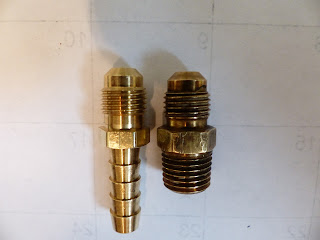An update as to progress on the fuel system. Running the fuel line to a five gallon gas tank was a great suggestion so that's how I decided to proceed. I took the fuel line off the Racors and that's when I noticed the fitting at the fuel pump seemed really loose. The fitting comes out of the pump then there's a 90 degree elbow then another fitting to the fuel line. I could turn the fitting 1/8 of a turn and it would tighten up. Turn it 1/8 of a turn the other way and it's just plain loose. Not good at all. I removed the fitting from the pump in order to put some pipe dope on it before I reinstalled it. That's when I noticed it was a flare fitting. I didn't think that seemed right so I called Brian up at American Diesel and asked him what the proper fitting should be. Sure enough, it was supposed to be a flare fitting, but and this is a big but, the proper fitting for that fuel pump has a longer then normal flare portion. The fitting that was in there never sealed at the flare portion, but bottomed out at the "nut" portion of the fitting. There was never a good seal and with it being loose, well that answers lots of questions. Take a look at the picture to see the difference. It's a very small difference indeed. Proper fitting is on the left.

So while waiting on that fitting to arrive I transferred fuel from the starboard tank to the port tank using the Gulfcoast polishing system. Worked like a charm. Opened up the inspection port and inspected the inside of the tank. Looked pretty good. The tank was slightly sloped towards the inspection port and in that corner I removed maybe a cup and a half of diesel "mud". The tank was rust free except for a small portion at the top. There was a light coating from where condensation had formed. Maybe two square feet total. The tank did not look to be original. With that side clean, the polisher then pumped all the fuel back into the starboard tank. The port side tank was much the same so it was cleaned and buttoned up. I had the polisher then pump over to the port side tank to even the levels out. So' I'm really happy about the condition of the tanks. They'll probably outlast me. And the fuel, well, it's been polished almost three times now. I don't think it could ever be any cleaner!
Installed the new fitting when it arrived and changed out the fuel line as well. Since I also changed the secondary fuel filters I knew there was some serious bleeding of air ahead. After about five minutes of pumping that tiny little lever, I thought there had to be a better way. I started looking at the polisher and thought maybe I could arrange the valves in such a way as to use it to send fuel to the filters. It worked. Five minutes later everything is bleed and it's time to fire up the engine. It took about three tries, but she fired right up. Shut her off and tried again. This time took about two seconds and she was purring.
Took her off the dock to run down the river to check things out. I was going to run the RPM and speed numbers, but didn't have the time. I did run her up to WOT and she held at 2300. Remember, before she won't hold 2000. The engine just sounds better too, if that makes sense. Next week I hope to get the RPM and speed numbers again and then decide if I should live with this prop or tweek it. WOT should be 2600. I'm thinking something closer to 2600 should be better for the engine. In the meantime, I'm really happy that I've got a thoroughly clean and inspected fuel system!
